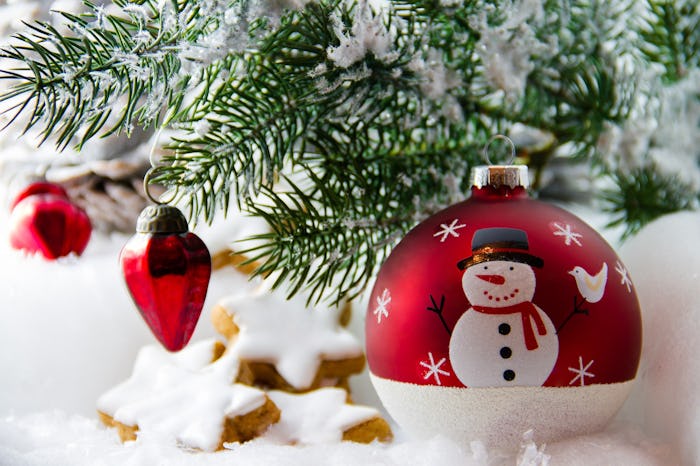Life
If You're Planning On Trying Some Tree-Flocking, Here's What You Need To Know
Here in the heart of the Midwest where I live, we're perfectly happy avoiding snow as much as possible. So while I admit there is something special about the white Christmases we've had, I don't feel the need to see snowflakes on my tree — I'll get plenty of that in the next three months. That being said, I totally get the tree-flocking craze, especially from those celebrating the holidays in warm climates. Flocked trees are attractive and festive, but are they toxic? Before jumping on the trend, parents should probably first be asking, "Is tree-flocking safe for kids?" The answer might lie in your method.
The word flocking simply means the process of attaching tiny fibers to a surface for creating texture, and is a concept also used in fashion, home decor, and various forms of arts and crafts. Christmas tree flocking, which can be done to both live and artificial trees, really took off in popularity in the late 1950s with DIY home kits that included guns to attach to your vacuum cleaners, according to Mental Floss.
These days it's easy to find pre-flocked trees in almost any store that sells Christmas decorations, but as they can get rather pricey, many people still prefer to do it themselves at home. Luckily, your vacuum cleaner is no longer required.
The internet is bursting at the seams with home flocking recipes using items like soap flakes or even desiccated coconut flakes; just try one quick search on Pinterest to find more options than you cared to know existed. But according to Southern Living, the most popular method of tree flocking is using a store-bought flocking spray or powder. And once your flocking-hungry heart leads you past the homemade recipes with ingredients you can see, it's harder to ascertain what chemicals you are bringing into your home, right at your kid's eye (and uh, hand and mouth) level.
According to my foray into internet research, store-bought flocking spray may contain chemicals like solvents, propellants, and flame retardants. Depending on your personal convictions, you may or may not be worried about such chemicals existing within your home, but it would be a good idea to think twice about how their presence might affect small children. Is little Johnny still in a stage where he is inclined to put his hand in his mouth after touching something? If so, I'm guessing solvents are likely not your preferred method of teething relief.
And then there's the option of having your artificial or live tree professionally flocked. This method is usually done by mixing bleached paper pulp with corn starch, which is generally safer sounding than what you'll find in a can on the shelf of a craft supply store. But professionals may add borax — the safety of which is disputed — as well as adhesives and flame retardants.
But if you have wee ones running around this Christmas, you aren't disqualified from enjoying the white tree of your dreams. One quick Google search for homemade flocking recipes or nontoxic flocking spray should provide you with a plethora of safe options. But if you do pull the trigger, keep in mind that if your littles are still in the touchy-feely stage of life, you might end up with four weeks of mess on your hands. And if you are an environmentally conscientious person, keep in mind that flocked Christmas trees can't be recycled; so if yours is a live one, it will have to go straight to the landfill come January.
Depending on the method you use, flocking a Christmas tree should be relatively safe. It's up to you to decide what risks you're willing to take and how important it is to your decor scheme and overall holiday experience. But one way or another, the holidays always somehow turn out magical. So even if your tree's a bit of a dud right now, my guess is that whether white or green, it'll be looking awfully beautiful on Christmas morning.
Check out Romper's new video series, Romper's Doula Diaries:
Watch full episodes of Romper's Doula Diaries on Facebook Watch.
